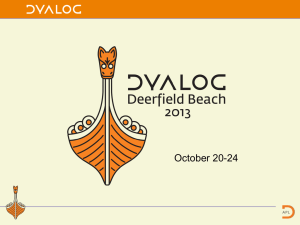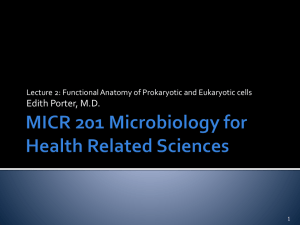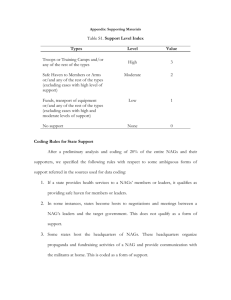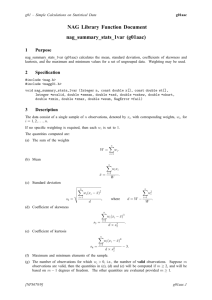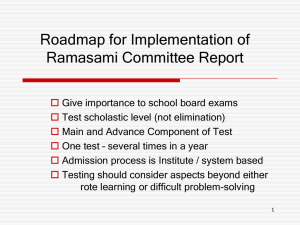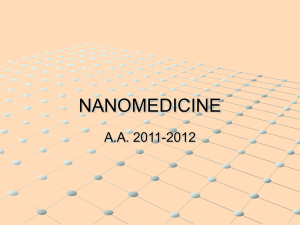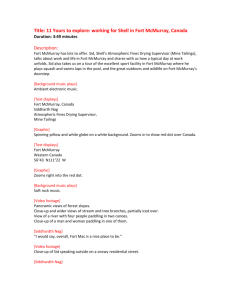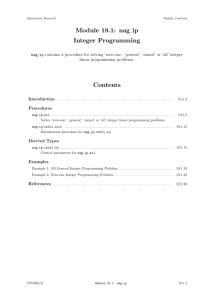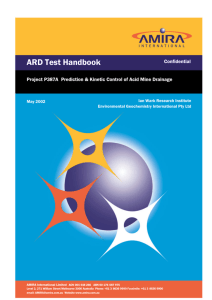PREPARING A MANAGEMENT DOCUMENT FOR
advertisement
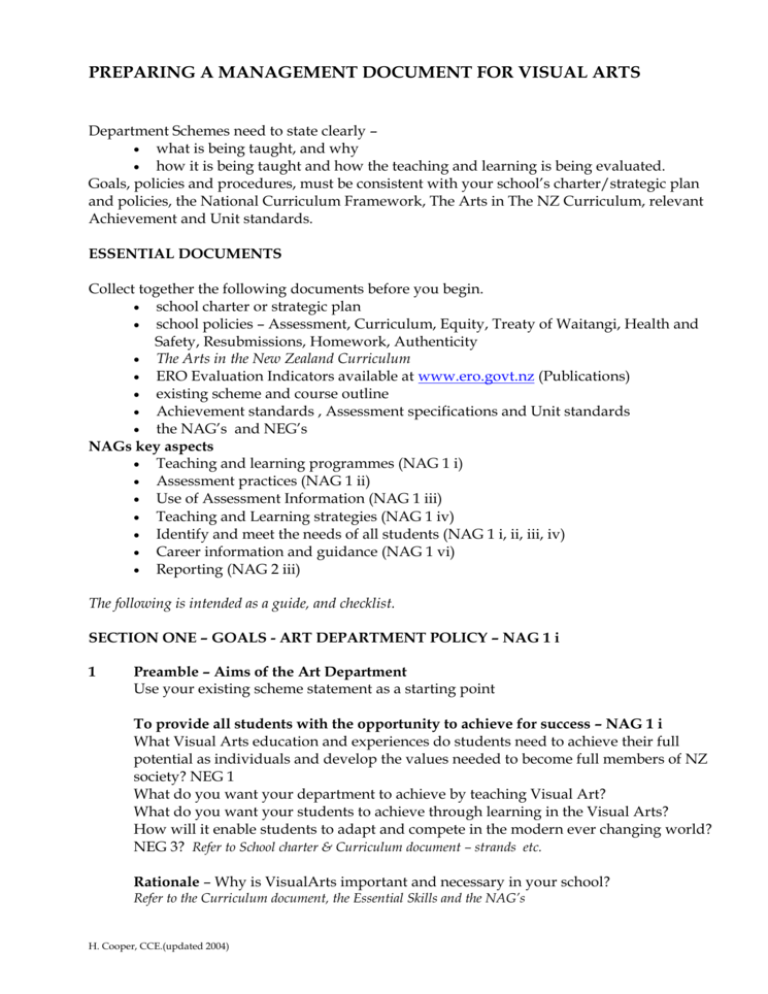
PREPARING A MANAGEMENT DOCUMENT FOR VISUAL ARTS Department Schemes need to state clearly – what is being taught, and why how it is being taught and how the teaching and learning is being evaluated. Goals, policies and procedures, must be consistent with your school’s charter/strategic plan and policies, the National Curriculum Framework, The Arts in The NZ Curriculum, relevant Achievement and Unit standards. ESSENTIAL DOCUMENTS Collect together the following documents before you begin. school charter or strategic plan school policies – Assessment, Curriculum, Equity, Treaty of Waitangi, Health and Safety, Resubmissions, Homework, Authenticity The Arts in the New Zealand Curriculum ERO Evaluation Indicators available at www.ero.govt.nz (Publications) existing scheme and course outline Achievement standards , Assessment specifications and Unit standards the NAG’s and NEG’s NAGs key aspects Teaching and learning programmes (NAG 1 i) Assessment practices (NAG 1 ii) Use of Assessment Information (NAG 1 iii) Teaching and Learning strategies (NAG 1 iv) Identify and meet the needs of all students (NAG 1 i, ii, iii, iv) Career information and guidance (NAG 1 vi) Reporting (NAG 2 iii) The following is intended as a guide, and checklist. SECTION ONE – GOALS - ART DEPARTMENT POLICY – NAG 1 i 1 Preamble – Aims of the Art Department Use your existing scheme statement as a starting point To provide all students with the opportunity to achieve for success – NAG 1 i What Visual Arts education and experiences do students need to achieve their full potential as individuals and develop the values needed to become full members of NZ society? NEG 1 What do you want your department to achieve by teaching Visual Art? What do you want your students to achieve through learning in the Visual Arts? How will it enable students to adapt and compete in the modern ever changing world? NEG 3? Refer to School charter & Curriculum document – strands etc. Rationale – Why is VisualArts important and necessary in your school? Refer to the Curriculum document, the Essential Skills and the NAG’s H. Cooper, CCE.(updated 2004) The rest of the scheme should demonstrate how your department will achieve these goals with specific objectives and strategies to attain them. The list seems exhaustive and unobtainable – a scheme is never finished - it is always a work in progress. Establish a folder, set up some headings from the following list, consider the questions raised, prioritise sections and then add documents as you can. SECTION TWO - OBJECTIVES How will you achieve your goals and the National Education Goals? 1 Assessment and Record Keeping – NAG 1 ii what and why are you assessing, how valid are your assessment tasks? will you have common assessment tasks and how will they be developed? collection of exemplars to maintain consistency of standards? How will you select, store them, how many, will you keep a photographic record? diagnostic, formative, summative – what variety of assessment methods will be used, how will you monitor them? NAG 1 ii what records will be kept? What are the school requirements? how will students’ progress be tracked? how will you analyse and use the data to evaluate progress and achievement – NAG 1 ii, ? how will assessment be used to identify students at risk of not achieving, or have special needs, including gifted and talented – NAG 1 iii? How will this information be used- see teaching and learning strategies below. Qualification opportunities- what standards, qualifications are offered? NEG 8 How do they best meet the needs of students? What quality assurance policies and procedures are in place ? How do they meet the requirements of NZQA moderation guidelines and assessment specifications? How are students encouraged and supported through assessment procedures? What procedures do you have for monitoring authenticty 2 Teaching and Learning strategies – NAG 1 iv what strategies do you have in place to address the needs of students identified as not achieving at risk of not achieving special needs ESOL gifted and talented (NAG 1 iii NEG 1, 7)? What barriers to learning are identified, and what strategies are implemented? NEG2 What strategies do you have to develop learning in Essential skills – to year 10 Te Reo Literacy numeracy skills? (NAG 1 i) how do you support your schools plans for raising Maori (and Pasifika) achievement? NAG 1 v NEG 9 are all programmes culturally inclusive? Recognise, include and build on students’ own experiences NEG 10 H. Cooper, CCE.(updated 2004) how is a balanced and broad education supported by the Visual Arts programme? NEG 5 what strategies are in place to meet aspects of the curriculum which require particular attention? CI, UC strands? equity considerations – commitment to gender, Treaty of Waitangi and cultural issues in topics, artist models, books etc? do you have affirmative action policies appropriate to the pupils at your school? how are students identified? tracked? scheme should include course statements and outlines for LEA students and enhancement and/or accelerated programmes for Gifted and Talented 3 Reporting to students, parents, community – NAG 2 iii Consistent with school policy what data is needed for student reports and how is it collected? what is the format of student reports? How do you report on Achievement Objectives/ strands and progress towards achievement standards? are achievement levels in reports analysed and collated- for particular groups of students? Male, female, Maori, Pasifika, ESOL ? 4 Evaluation and Departmental Review how are the programmes, student achievement reviewed? how are you monitoring the progress of your students and the effectiveness of your programme? how and how often do you review your department? - school policy? – are staff/pupils/parents involved? how is the above information used in planning – have you formulated a Strategic Plan? Do you have current department goals, long term objectives? NAG 2 i? what is your staff appraisal system? 5 Community Links consultation with the community about events relating to the art department, or delivery of the curriculum? how are contacts made /encouraged with parents of students from diverse backgrounds? ..are parents invited into the classroom? how do you share student’s learning, achievements and experiences with the community? 6 Careers Advice – NAG 1 vi at what levels, by whom? co-ordination with school’s career adviser access to information from tertiary providers information evenings for parents providing guidance /information on pathways access to qualifications/ star courses etc? H. Cooper, CCE.(updated 2004) 7 Human Resources staff – their allocations of classes and responsibilities provisionally registered and new teachers – what assistance are they given, how is their progress monitored? Ancillary hours? – responsibilities and hours Arts co-ordinator – role/duties 8 Physical Resources how many Arts rooms/resource areas are there and what is their equipment? how do you organise resources – order consumables, storage etc? what book resources do you have – systems for storage, allocation and maintenance? speciality equipment – allocation, maintenance, replacement? policy for student access- hire? Eg cameras, digital camera 9 Budget how is the budget allocated between departments? do photography, art history have separate budgets? how is the budget divided between consumable, equipment, maintenance, computers, books etc, how do you monitor spending? what other sources of income does the department have? costs to students – material fees? do you sell consumables to students? How is money collected, recorded etc? how is photocopying budgeted and managed? Is it limited per teacher? Is there an art acquisition allocation? 10 Homework list homework requirements at all levels how does you policy reflect the school policy? what strategies are used to maintain this policy? 11 Field Trip Organisation is there a policy? communication with parents, costs, collection of money, transport system for applying for trips, are they set annually in the school diary, time out of other subjects? gallery visits 12 Competitions and Student Exhibitions are students encouraged to participate in any/some/all? displays of student work for the school/parents/ community 13 Computer Facilities and other technologies what departmental computers, digital cameras, scanners etc are available for staff/student use? are computers used as a tool in visual art programmes – at what levels? H. Cooper, CCE.(updated 2004) what access do senior students have out of class time to complete work? who is responsible for maintenance? does the department have internet access and how is it monitored? is there a school intranet? 14 Library are the library resources checked by art staff – do you supply lists for recommended purchase? is there a policy on library use? are art department books catalogued with the library – can they be issued? 15 OSH – Health and Safety is there a policy? do students work after hours? – consider parent approval, safety, times etc storage of solvents and chemicals first aid equipment – accessibility and maintenance for classrooms and darkrooms are policies and guidelines in place for specialist rooms: dark room, print room, computer facilities ? 16 Co-ordination with other departments/faculties liaison with other arts subjects – music, drama and dance does the department have a responsibility to other departments, e.g. technology or school projects, e.g. productions 17 Departmental, faculty Meetings when, how often? – what is the purpose of them? who chairs them, records minutes? H. Cooper, CCE.(updated 2004) H. Cooper, CCE.(updated 2004)
